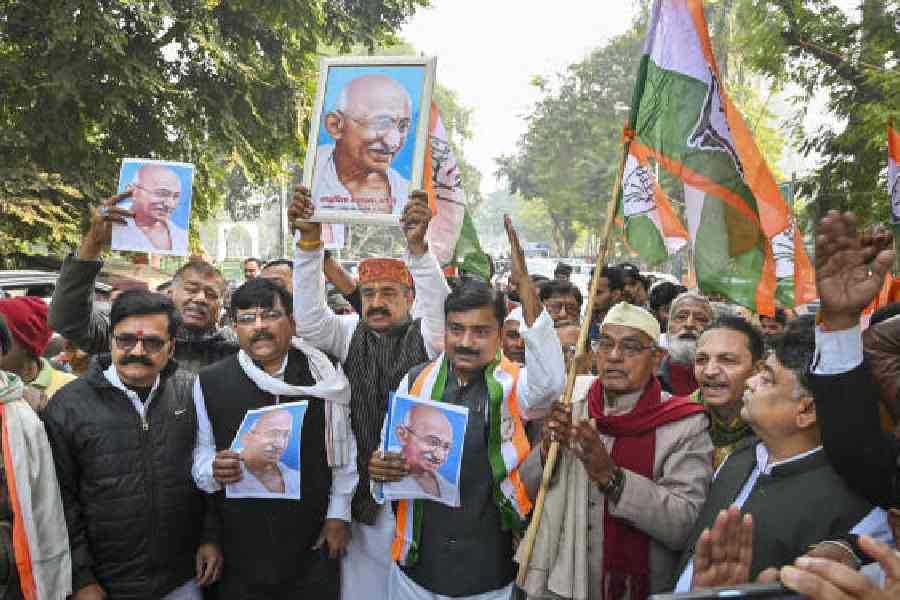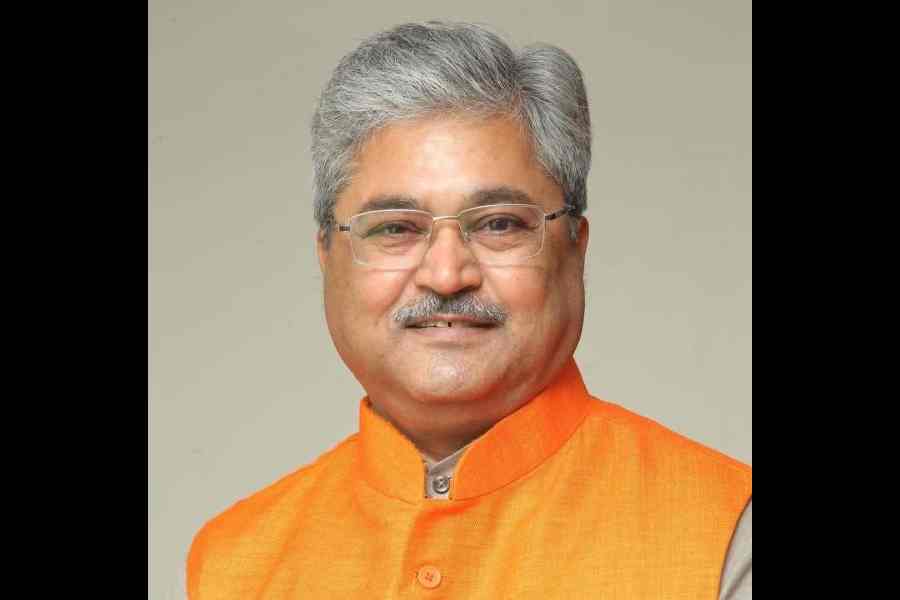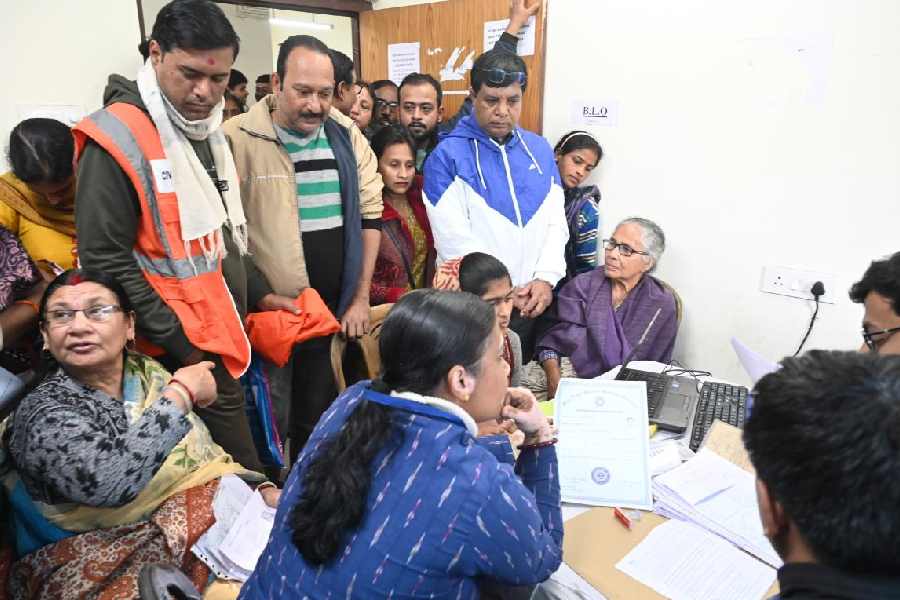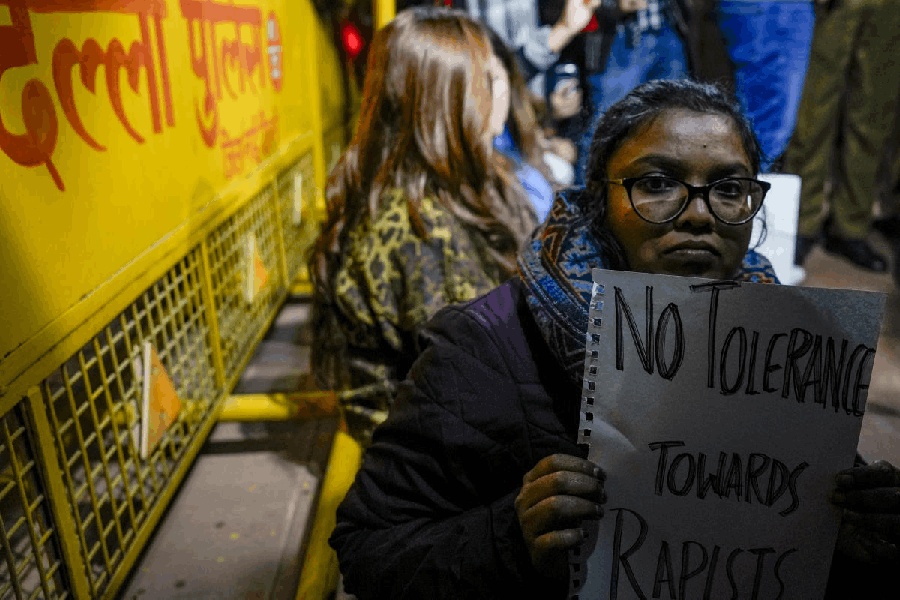|
|
A wooden picture frame hangs on a wall inside the Kumartuli Mritsilpa Sanskriti Samity office. The photographs inside are covered with a film of dust, lending the images a degree of anonymity. Peering closely, I saw that even the famous faces are a blur: I could only make out a much younger Bhimsen Joshi and Buddhadeb Bhattacharjee. At the deserted office, I was waiting to talk to Babu Pal, a Samity member. I wanted Pal to tell me why the government’s proposed rehabilitation plan for Kumartuli’s artisans had reached yet another impasse.
The chief minister had announced a development plan for this artisan colony years ago. A centre for the arts is supposed to replace the existing workshops in Kumartuli. Reportedly, the funds have been arranged and only a site needs to be selected to rehabilitate the artists temporarily. The three earlier sites —at Sethbagan, an unused factory at Kashipur, and an abandoned warehouse near Rabindra Sarani — have all been rejected. The fourth — the stretch between Strand Bank Road-Bagbazar Lockgate and Sovabazar ferryghat — has now run into trouble, with local residents opposing the move. I was hoping that Pal will be able to tell me whether he thought that the wait will get even longer.
Seven plastic chairs and a cat kept me company. There was a radio playing somewhere. Outside the door, on a lane criss-crossed with light and shade, I could see the idol-makers working in dingy, decrepit workshops. I looked up at the dust-covered pictures and realized that they did not look out of place. Not one bit.
My phone rang. It was Pal who had called to let me know that he would be late. I decided to step out and take a stroll through the dirty, serpentine, yet inexplicably beautiful lanes. Once outside, I smelt the river nearby. There were other smells too — those of clay, paint, wet bamboo frames and that unmistakable scent of penury. (Even the chief minister had managed to catch it years ago. Moved, he devised his grand revival plan for the artists.) What I saw, however, made me forget temporarily what I smelt. The workshops were full with idols, some finished, others half done: a cheery Ganesh with two crooked tusks, the Goddess astride her lion, Vishwakarma and his benign elephant. I could also see familiar names on painted signboards — Romesh Chandra Pal, Sanatan Rudrapal, Sudhir Kr. Pal.
A while later, I chanced upon Biswanath Mukherjee, a frail old man who sat smoking outside the Kumartuli Mritsilpa Kamgar Samity. We began to talk and, in the course of the conversation, I told him he reminded me of Shashibabu. The old man smiled. Perhaps he didn’t know that Shashibabu was the doomed idol-maker in that Satyajit Ray film, Joy Baba Felunath.
As he and I chatted, I began to make sense of Mukherjee’s doom in a way. The old man has spent five decades working in Kumartuli (he now works for the renowned Nepal Pal) and has seen the times change — the demise and disappearance of Muslim artisans, Kumartuli’s burgeoning growth (there are now, officially, over 150 workshops, although Mukherjee prefers the term ‘factory’). Even the Goddess’s clay ornaments have given way to shimmering tinsel. But soft loans are now available to take care of the business and Mukherjee no longer has to work 18 hours a day. Some things in his life have remained unchanged though. He still draws a meagre salary and works on contract. He has no pension or insurance.
I ask him whether he has heard of the government’s rehabilitation plan. He asks me whether I know when it will happen. Then, with his thin finger, he draws an invisible arc in front of my face. Idols in the traditional style are coming back once again, he says. The circle will soon be complete, but he still doesn’t quite know whether his life, whatever remains of it, will change. What would he miss about this decrepit locality if things were to change, if he were to go to go away to some other place? His workshop and the river, he answers wistfully.
Sudhansu Sil, CPI(M) member of parliament, shares none of Mukherjee’s uncertainty. Sil, a key member of the Kumartuli rehabilitation committee, believes that it is time that things changed. He assures me over the phone that the government is doing all that it can to improve the locality’s condition. He is quick with facts and his figures are precise. I too am swayed by his quiet optimism, momentarily.
Kumartuli, he informs me, is being developed under the auspices of the Jawaharlal Nehru Urban Renewal Mission, which aims at holistic development. There will be something in it for both the artists and the residents. While the slum dwellers will get better civic amenities, including new houses and toilets, the idol-makers have been promised better infrastructure (roads, sanitation, fire-fighting equipment) as well as a centre for the arts. Benefits such as insurance and pension will also be considered. Sil’s voice ebbs a bit when I ask him about the time of the project’s completion. He cannot put an exact date he says, and adds that matters like temporary relocation drag on a bit.
I begin to see the reason behind the sceptical voices earlier. Babu Pal — he did manage to give me some time — is unsure about the government’s commitment to Kumartuli’s development. The project can only start if the government manages to find an alternative, temporary site for the craftsmen. The proposed stretch between Strand Bank Road and Sovabazar is unsuitable for the purpose because of its congested nature. Relocating Kumartuli’s workshops there will make matters worse. Pal also sounds sympathetic to those who are opposed to the plan of temporarily relocating the workshops to the contentious stretch: “It will make the congestion worse and further inconvenience the residents.”
So where does all this leave people like Mukherjee and Pal? “In a workshop lodged between despair and hope,” Pal answers, laughing. I do not miss the hollow ring to his mirth.On my way back, I pass by the workshop where Biswanath Mukherjee works. I look inside into the gathering darkness, and all I see are the shadows of the towering idols. Somehow, I cannot imagine the old man at work in a clean and bright modern studio. That will keep him near, yet so far, from the things he loves.











